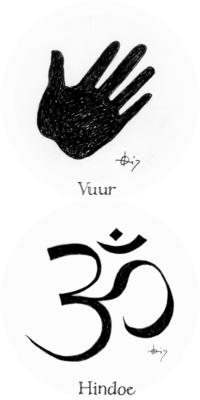What is Hinduism?
Nivedita Yohana
Hindoe richtingen — Oorsprong, ontwikkeling en filosofie van het hindoeïsme — De Veda’s, AUM en de heldendichten — Yoga scholen of wegen — Hinduism: an overview — Perspectieven vanuit de Advaita Vedānta — Kastenstelsel
Brahmanism or Hinduism is not only the oldest of the mystery religions, or rather metaphysical disciplines, of which we have a full and precise knowledge from literary sources, and as regards the last two thousand years also from iconographic documents, but also perhaps the only one of these that has survived with an uninterrupted and unbroken tradition.
That is lived and understood at the present day by millions, of whom some are peasants and others learned men well able to explain their faith in the west as well as in their own languages.
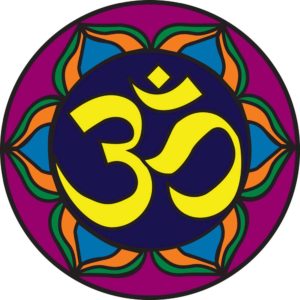
Nevertheless, and although the ancient and modern scriptures and practices of Hinduism have been examined by western scholars for more than a century, it would be hardly an exaggeration to say that a faithful account of Hinduism might well be given in the form of a categorical denial of most of the statements that have been made about it, alike by western scholars and by Indians trained in our modern skeptical and evolutionary modes of thought.
An umbrella
Hinduism is not a religion in the way that we might understand Christianity, Islam or Judaism to be. It was never established, by any one individual or group of individuals, as a unified body of faith and practice. It has no fundamental set of guidelines or doctrine, and no central religious authority. It has no central scripture or body of scriptures equivalent to the Bible or the Qur’an.
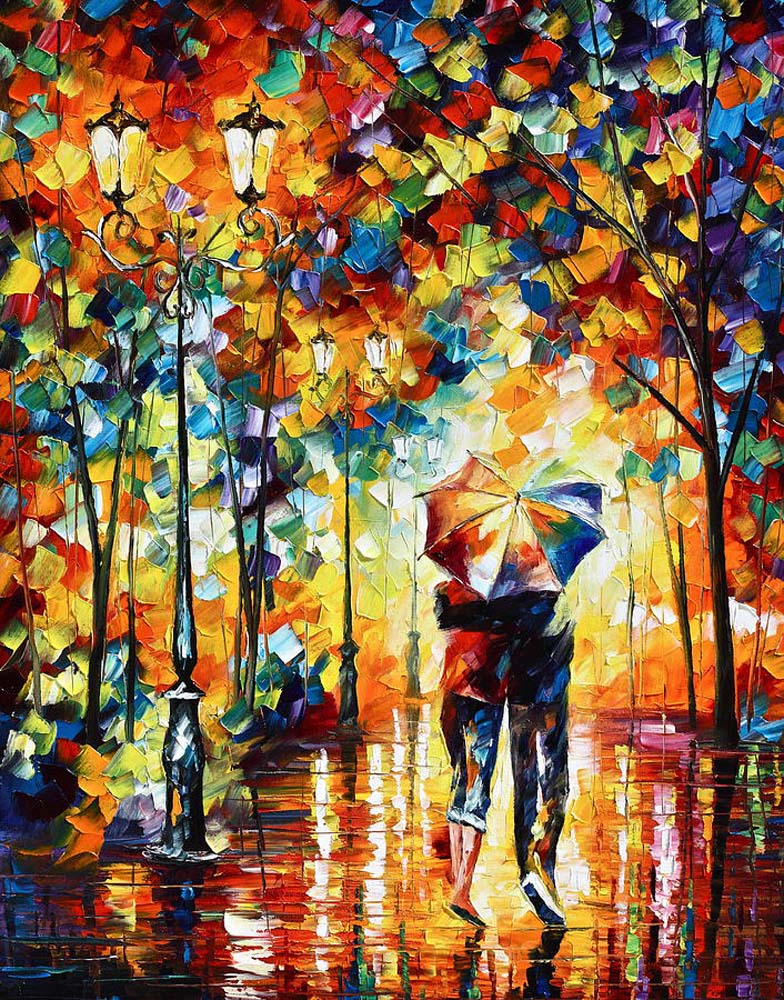
As an umbrella term of relatively recent coinage, surrounding a variety of creeds, textual traditions, religious figures of authority, and religious groups and organisations, ‘Hinduism’ is very challenging and complicated to pin down in a definitive sense.
The term ‘Hindu’ has a longer history than the term ‘Hinduism’. It was used, as far back as the middle of the first millennium BCE, by Persian conquerors, to refer to indigenous or native populations living along and beyond the river Sindhu, flowing along the north-western frontiers of the Indian subcontinent.
The term had no obvious religious significance. It referred only to a geographically defined population which, over time, came to be marked by immense diversity of languages and customs. Gradually the indigenous population began to use this term to distinguish themselves from ‘foreigners’ — for instance, Muslim conquerors and settlers from central Asia, European traders and explorers, and also travelers and merchants visiting India from other parts of the world.
The term ‘Hinduism’ was coined relatively recently, in the 19th century, as the term ‘Hindu’ began to be invested with religious significance.
It was used to refer to a diversity of socio-religious beliefs and practices that have long been prevalent in the Indian subcontinent, and whose origins date all the way back to the second millennium BCE.
This usage followed in large part from British orientalists’ discovery of ancient Indian liturgical and philosophical traditions in Sanskrit.
The term ‘Hinduism’ came to be identified with the religious traditions of Indian people, and Indian reformers too in due course came to use this term to refer to the ‘religion’ of the Hindus.
Devotion
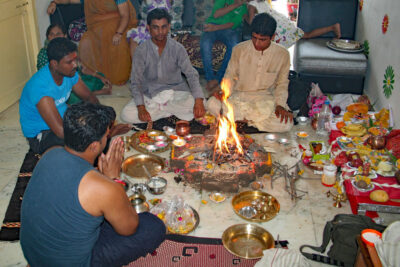
Puja is a ritual of love or devotion (bhakti) to a deity with whom the devotee often establishes an intense and personal relationship. Corresponding to the growth of theism and devotionalism, Sanskrit narrative traditions evolved.
Most important of these, besides the Puranas mentioned above, are the itihasas (historical epics) — the Ramayana and Mahabharata — and devotional poetry in several Indian regional languages.
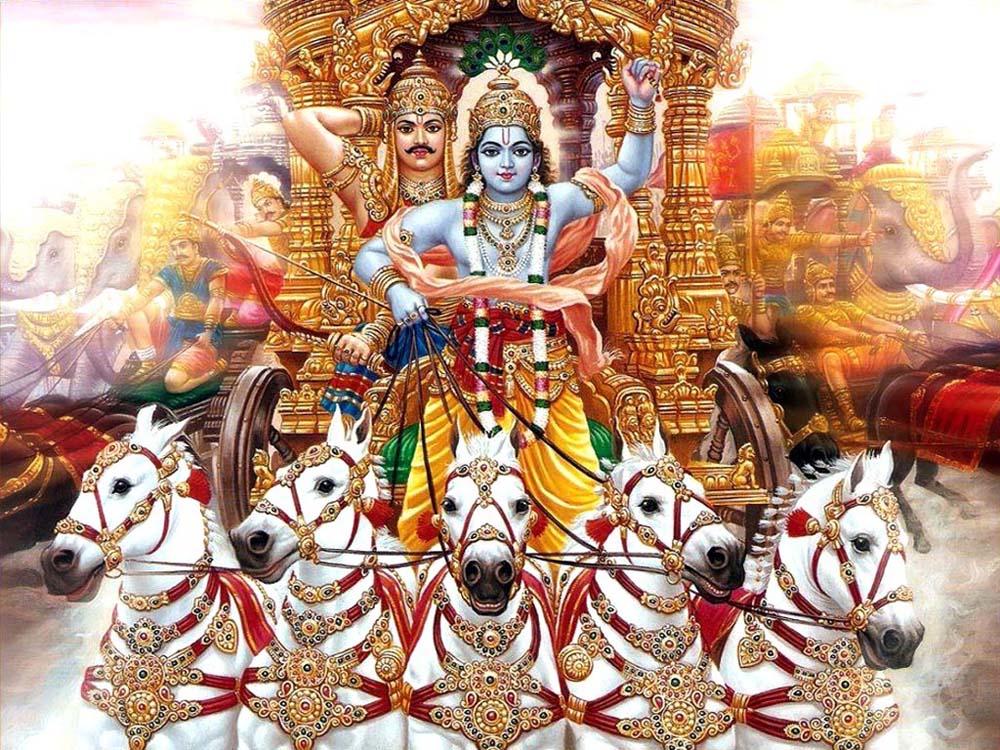
The Bhagavad Gita, ‘The Song of the Lord’, contained in the Mahabharata, is one of the most famous Sanskrit narrative texts. In the Bhagavad Gita, the great god Krishna reveals his divinity to his friend Arjuna, and expounds the main concerns of Hindu orthodoxy — responsible action, the maintenance of social order and stability, and the importance of devotion to the divine transcendent as a personal god.
Genesis
The earliest traces of what we understand today as ‘Hinduism’ go back to 2500 BCE. Between about 2500 and 1500 BCE, an ancient urban civilization flourished along the banks of the river Indus. Archaeologists excavating various sites associated with this civilisation have unearthed terracotta figurines which bear a striking resemblance to images of later Hindu deities.
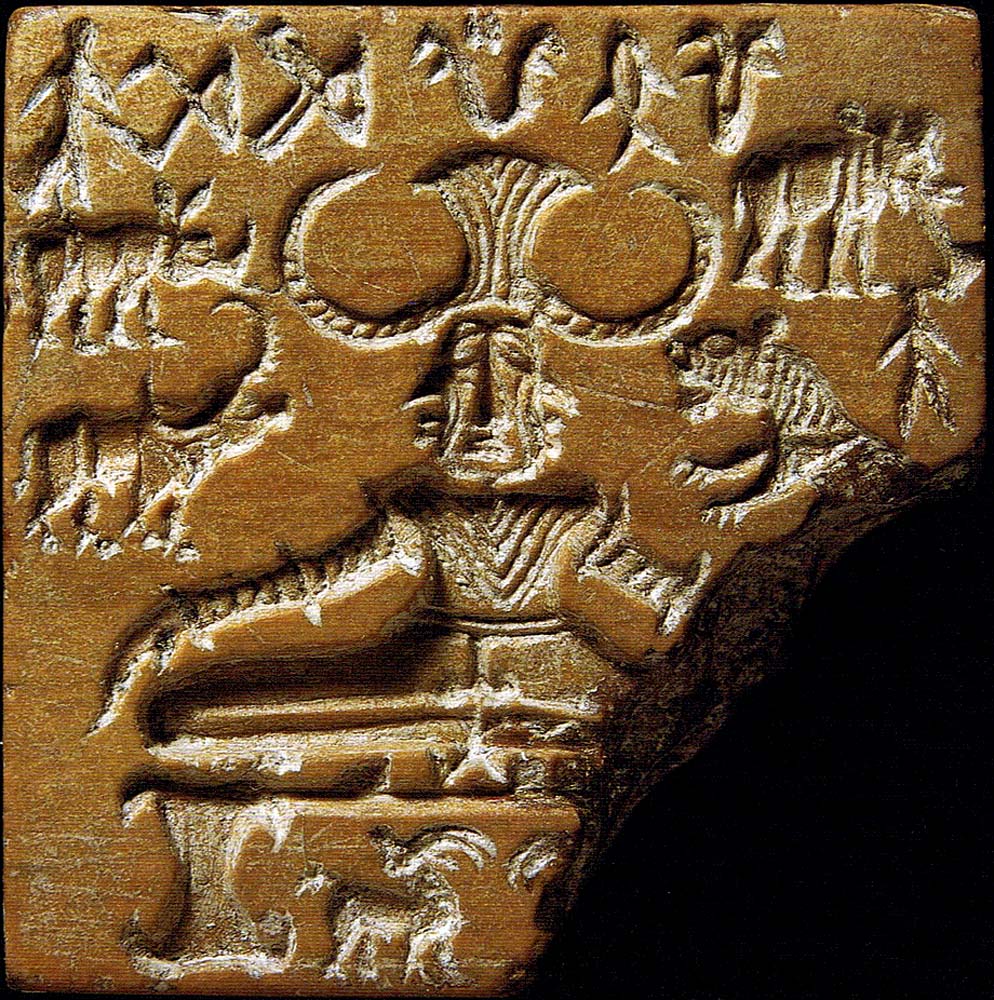
There is to date no consistent evidence to confirm historical continuity between present day Hinduism and the ancient civilisation of the Indus Valley.
Following the rather sudden decline of this civilisation between 1800 and 1700 BCE, there arose the civilisation of the Aryans, and the history of Hinduism as we understand it today is the history of the next 2,000 years of Aryan culture in the Indian subcontinent.
From the 11th century CE onwards, large sections of the Indian subcontinent were conquered and ruled by Muslim kings and emperors from central Asia.
The rule of the last Muslim emperor in India came to an end in the 19th century, and British forces, initially in the form of the East India Company, and later the British crown, came to assume control over the economy and administration of the Indian subcontinent.
Western Indologists and Orientalists took considerable interest in the Hindu traditions they encountered in India, either reviling Hindu belief and practice as heathen and depraved, or glorifying certain textual and Sanskritic aspects of Hinduism for their wisdom and intellectual prowess.
Hindus, who had tended to be relatively insular, now began to respond to the British, and more importantly Christian, presence in their midst.
Hindu reform movements arose, led by educated Indians, many of whom relied on a notion of a glorious Hindu past in order to assert a sense of a distinctively Hindu identity and pride in the present.
It was at this time that Hinduism came to be first understood as a religion. The reform movements, often collectively referred to as the Hindu renaissance, absorbed many of Christianity’s rationalist elements, and were often closely linked with India’s nationalist struggle for freedom from colonial rule.
Independence was finally achieved in 1947 and after gaining independence, India defined itself as a secular state.
International Hindu presence
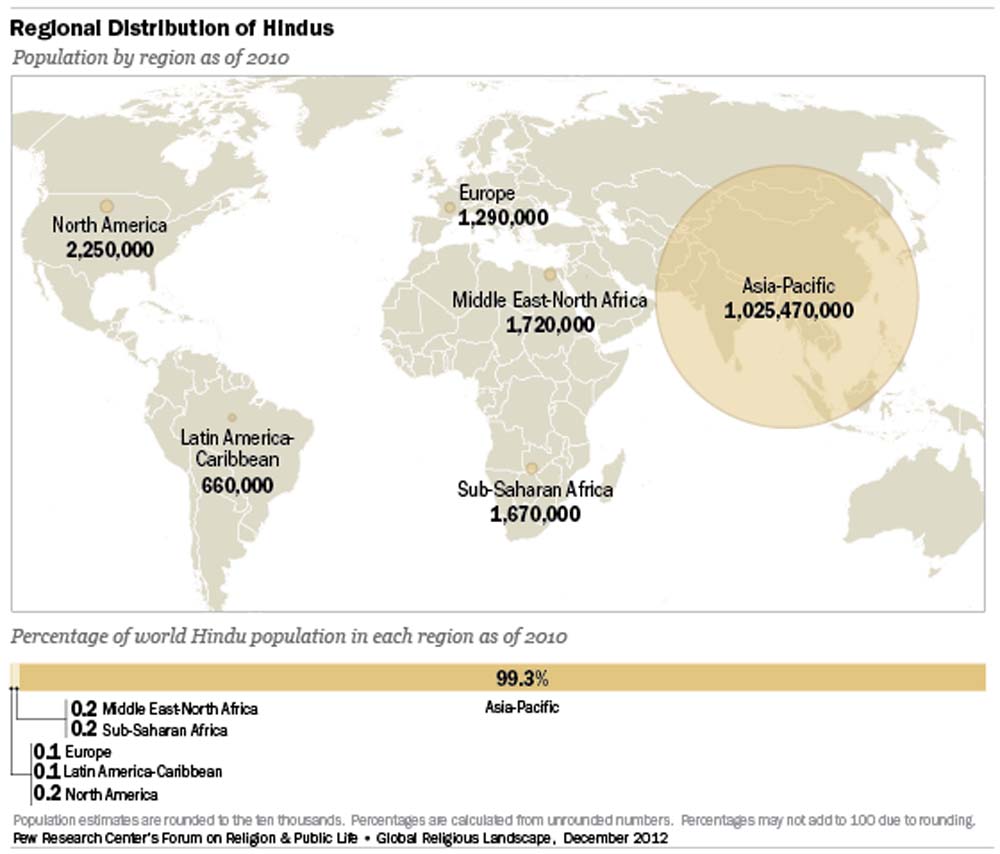
In India currently about 80% of the population of over one billion is Hindu.
In neighbouring Nepal, where Hinduism is the state religion, over 90% of the population is Hindu.
Hinduism has long had a presence beyond the Indian subcontinent in countries such as Cambodia, Thailand, Bali, Myanmar, Malaysia, Mauritius and other parts of southeast Asia. The early part of the Hinduism 19th century saw the movement of Hindus to countries in East and South Africa, Trinidad, Surinam and Guyana, Fiji, and Mauritius.
More recently, in the 20th century, sizeable Hindu populations moved to Britain, North America and Australia. Differences in terms of colonial traditions and immigration policies have led to different patterns of settlement and community formation in each of these host countries.
Given the diversity in Hindu belief and practice, it is nearly impossible to define such a thing as ‘the Hindu belief structure’ in the singular.
There is no one worldview shared by all Hindus; instead there are multiple Hindu worldviews. Identifying elements common to all of these is bit delicate and complicated. Hindus tend to treat these selectively, combining preferred elements of one with preferred elements of another, depending on such things as their social background, caste grouping and sectarian affiliation, age and sex, and also their personal preferences and inclinations.
Karma — Samsara — Moksha
Later Vedic texts, which tend to speculate about the meaning and purpose of life, contain central ideas about action in this world and life after death. These ideas today appear in various forms and guises in the belief systems of the majority of Hindus and in the teachings of Hindu gurus.
The cycle of birth, death and rebirth: samsara
It is believed, that all beings are reincarnated into the world over and over again. Life is therefore not finite, and does not come to an end with the death. Instead the soul lives on and is reborn into the world in a new body. The cycle of birth, death and rebirth, without beginning and without an end, is referred to as samsara.
One’s actions: karma
Secondly, one’s actions, karma, in this life determine the course of events in future lives. Good action in this life leads to conditions conducive to happiness in a subsequent life, and bad action leads to suffering. However, samsara as such refers to a world marked largely by suffering. The ultimate spiritual goal is therefore not merely to engage in good deeds and secure some measure of happiness in future incarnations; it is instead to secure release from the samsaric cycle altogether.
The release: moksha
This release, moksha, can be achieved through striving for inner discipline, cultivating detachment from the affairs of this world, and in quest of spiritual enlightenment.
Dispelling common stereotypes and misconceptions
Generalising about Hinduism
A common mistake made by Hindus and non-Hindus alike is to treat Hinduism as a unified and cohesive category. The beliefs, practices, sensibilities and sensitivities of Hindus are in fact best understood not as representing ‘Hinduism’ in a generalised sense, but as reflective of the regional and linguistic background of the persons concerned, their caste status and sectarian affiliation.
An upper caste Hindu, for instance, whose family has known all the benefits and privileges traditionally accorded upper caste members, may have a different set of sensibilities than a Hindu of a lower caste, whose caste group may have suffered centuries of discrimination and exploitation.
Equally, a British Hindu whose parents arrived in Britain from India fifty years ago would have very different sensibilities from one who was born and brought up in Trinidad and moved to Britain as an adult in search of employment.
Confusing ‘Hindu’ and ‘Indian’
Another such mistake is to treat the categories ‘Hindu’ and ‘Indian’ as interchangeable. It is important to remember that not all Indians are Hindus. India has a sizeable non-Hindu population.
Equally, not all Hindus in today’s globalised world are Indian. Some Hindus may have Indian roots often going back several generations, but may prefer to see themselves not as Indian but as, for instance, Trinidadian, or Fijian, or Balinese, or British.
Others, such as Western followers of ISKCON who call themselves Hindu, may have no Indian roots at all.
‘Othering’ and stereotyping Hindus
The problem only gets further compounded when Westerners draw exaggerated contrasts between the ‘Western self’ and the ‘Hindu other’.
The first tends to describe Hindus as idolatrous, polytheistic, and primitive. It emphasises such relatively rare Hindu practices as animal sacrifice and widow burning as the defining characteristics of Hinduism, and contrasts these with supposedly ‘civilised’ elements of Christian and Western selfhood.
The second perception tends to glorify Hinduism, highlighting particular aspects of Hindu philosophy as its defining features, and setting up a contrast between Hindu spirituality and Western materialism.
The third view tends to see Hinduism, as mysterious, hippie, exotic, elusive and alluring. None of these are helpful perceptions. All three tend to represent Hinduism (and indeed Western worldviews) in stereotypical terms which have no bearing on the complexities of the real world.
Racism
The most common problem faced by Hindus is one shared by most immigrants of South Asian origin. They are frequently the victims of racial intolerance and religious bigotry, or simply of Western ignorance and indifference.
A lack of understanding about differences between, for instance, Indians, Pakistanis, Sri Lankans and Bangladeshis, or between Hindus, Muslims, Sikhs, Buddhists and Jains, leads to a lack of sensitivity to, and disregard for, the multiplicity of belief systems, life styles and religious orientations prevalent among South Asian immigrants.
Equally, a lack of understanding of their socio-economic conditions, of their everyday struggles and challenges, and of the gradual changes in their values and beliefs resulting from their exposure to various cultures through media, leads to racial prejudice.
Not all Hindus are practicing Hindus, or believers in God. Not all Hindus are vegetarians. Not all Hindus attach the same degree of importance to the observance of festivals or rituals. There are no dress codes binding on all Hindus, no rules about dating, alcohol, smoking, and dietary habits that apply to all.
Shashi Tharoor, in his book “Why I am a Hindu” says:
After all, Hinduism is a religion that, in the Rig Veda’s Creation Hymn says, “Where has all this come from? Who made this world in the Heaven’s universe? Only He in the Heaven knows — or maybe He does not know.
Hinduism has no single founder or scripture or ‘truth’ to uphold but is an eclectic body of realisations; it is more comfortable with ambiguity and uncertainty than Semitic religions are. The strength of Hinduism is its eclecticism.
- Agarwal, V. (2014) New stereotypes of Hindus in western Indology. Wilmington, DE: Hinduworld Publisher.
- Gibson, L. (2003) Hinduism. Austin, TX.: Raintree Steck-Vaughn.
- Monier-Williams, S.M. (2012) Hinduism. Rarebooksclub Com.
- Pillai, R. K. (2003) Reaching the world in our own backyard: A guide to building relationships with people of other faiths and cultures. Colorado Springs, CO: WaterBrook Press.
- Tharoor, S. (2018) Why I am a Hindu. New Delhi: Aleph Book Company.
- Warrier, M. (2006) A guide to Hinduism. Leeds: Subject Centre for Philosophical and Religious Studies, Higher Education Academy, University of Leeds.
Notes
[1] Source: under one umbrella
[2] Source: puja at home – Yann Forget / Wikimedia Commons / CC-BY-SA
[3] Source: Arjuna choose Krishna his charioteer
[4] Source: Shiva Pashupati seal discovered during excavation of the Mohenjodaro archaeological site in the Indus Valley has drawn attention as a possible representation of a “yogi” or “proto-siva” figure.
[5] Source: global religious-landscape hindu


